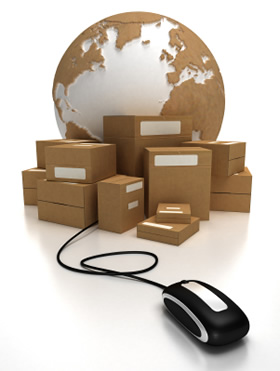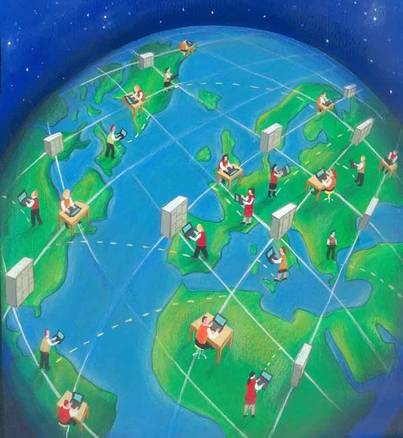
In this chapter, we learned about the different activities involved in B2B transactions. They include the purchasing, logistics, and support activities. We also talked about direct and indirect materials, and the different types of these materials. Finally we covered the ways in which the government is using technology to do various tasks; we also covered how businesses are gradually switching from the hierarchy model to the network model.
The purchasing activities in any given business may vary from business to business, but genrally they include the following steps:
- Identify and evaluate vendors,
- Select specific goods,
- Place orders,
- Resolve any issues that occur after the goods are received. These issues may include
- late deliveries,
- wrong amount of goods,
- wrong items,
- malfunctioning items.
By monitoring the purchase transaction, the managers can play a large role in quality and cost control. This is often reflected in the supply chain, which includes all the steps involved in the design, production, promotion, marketing, delivering, and support of each component involved in a product or service. Some supply chains can be rather small, but others, such as computers, can be highly complex.
One of the processes that can condense a supply chain is sourcing, or identifying possible suppliers and determining their qualifications. When this is done using technology, it is referred to as e-sourcing.
Another important aspect of the purchasing activities involved in a business is the company's spend, or the total dollar amount of all goods and services the company purchases in a year. Depending on the company's ability to control the spend, it could be a determining factor of how profitable the company is.
Direct vs Indirect Materials Purchasing
When talking about the materials purchased in a business, generally there are two categories, direct and indirect. Direct materials include all the items that are part of a finished product or service, while indirect materials are all the materials the business uses the production of the good or service, as well as the supplies and other items used throughout the business.
Direct materials are split into two catergories: replenishment and spot. Replenishment materials are those that a business uses very frequently, and as such, usually has a contract with the supplier to receive materials over a period of time. Spot materials are those that are not used as frequently, and are purchased only when needed to avoid having too much unneeded materials taking up space.
Some things, such as office supplies, computer hardware/software, and travel expenses, are usually labeled as MRO supplies, which stands for Materials, Repair, and Operating supplies. The purchases of these materials can be hard to control since they are usually very inexpensive and occur quite frequently. One way in which they have been able to gain some control over them is by using purchase cards, which are similar to a debit/credit card that can be used for making these purchases while still being able to track the transactions.
Logistics has one general goal: get the right amount of the right product to the right place at the right time. There are many aspects of logistics, which include:
- Materials management;
- Managing the receipt of materials and supplies;
- Managing the shipping of finished goods.
Use of the Internet has allowed for companies to have a better control over the different aspects listed above, as well as other aspects of shipping. For example, companies such as UPS allow for you to go on to their site, type in the information for an item being shipped, and you can see where it has been and where it is at that moment; this is all thanks to the use of GPS.

Support activities cover many facets of B2B activities. These include the following:
- finance and administration;
- human resources (HR);
- technology development.
In each area of support are numerous things that go on. For example, the Financial department budgets and plans the funds to make sure that the funds will be there when different obligations are needed to be paid; the HR department is usually in charge of the hiring, training (although some companies place this in the hands of the leader of a particular area of the company), evaluating, and if necessary, firing of employees; the Technology department is in charge of a large variety of activities, depending on the organization.
Companies are starting to integrate support activities into the Web site, which can serve a number of functions such as allowing the employees (past and present), business partners, and families of employes to perform many actions depending on the user. For employees, past or present, this allows for them to use the site to track the benefits they are receiving from the company, The company can also incorporate sales support for the customers who access the site.
Knowledge management is another process that is being aided by advances in technology. Companies can gather information about the manner in which the employees work, what processes are going on, and use this information in an attempt to make the working environment more efficient by integrating certain ideas into existing processes.

Although governments don't typically sell products or services to customers, they perform many functions for their stakeholders. Many of these can be enhanced by the use of e-commerce technology. They also provide business-like activities such as employing people, buying supplies from vendors, and distributing benefit payments of all kinds. They also collect taxes and fees from their constituents. The use of e-commerce by governments and government agencies to perform those functions are commonly called e-government.
Governments have also begun to use e-commerce technology in order to make their business processes much more efficient. This is commonly referred to e-government, and since 9/11, the U.S. government has begun to use Internet technologies to make information more available to all the government agencies. Other nations have also found that e-government can reduce costs and provide better services to the citizens of the country.
States, as well as the cities, towns, and villages in those states, have also begun to use the Internet to provide services to their citizens while cutting the costs associated with those services. Some of those services include:
- Local laws and regulations;
- Ability to renew drivers license;
- Promoting the area to prospective businesses;
- Employment listings;
- Tourism information;
- Tax forms and filing information;
- Information regarding doing business in the area.
The three different forms of economic organization include markets, hierarchies, and networks, and many businesses are making the shift from hierarchies to networks. One advantage of this is that businesses are giving their Procurement departments new tools to negotiate with suppliers, including the possibility of forming strategic alliances. Due to these opportunities, the "supply chain" is starting to be referred to as a "supply web" since industry value chains no longer consist of a single sequence of companies linked in a single line, but include many parallel lines that are interconnected in a web or network configuration.
Highly specialized firms can now exist and trade services very efficiently on the Web. The Web is enabling this shift from hierarchies to networks. These types of firms are more flexible and can respond to changes in the economy more effectively than those with a hierarchy organization. The roots of Web technology for B2B transactions lie in a very hierarchically structured approach to interfirm information transfer: EDI.